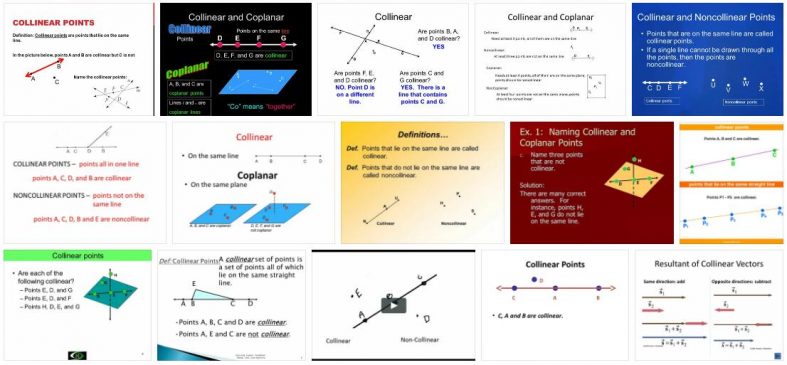The adjective collinear is used in the field of geometry to qualify a point that is located on the same line as another point. Suppose that, on line A, it is possible to find the points r, s, and t. These three points, therefore, are collinear: they lie on the same line.
To understand precisely what the idea of collinear refers to, we must define terms such as point and line. Points are geometric figures that, without volume, area, length or dimension, allow describing a certain position in space, based on an already established coordinate system. A line, for its part, is an infinite succession of points that develops in the same direction.
Graphically, a line is a line that could extend indefinitely both backwards and forwards, always in the same direction. All the points that are included in said line with collinear. If we draw a line B and in it we locate the points k and l, both will be collinear.
On the other hand, if point r is found on line A and point k is found on line B, these two points (r and k) are not collinear because they both belong to different lines.
It is very important to emphasize that the lines are imaginary and infinite, and in no way are they segments that we can trace on a sheet or a wall, but rather that these are part of them, in any case. For this reason, talking about lines and points is not as simple or decisive as talking about objects in the material world, such as being a pencil, which exists and cannot be another or not be seen.
However, something shared by a pencil and a line is that the name they receive is absolutely arbitrary, both due to issues of the language used to name them and the decision of the speaker when addressing them: in each language the words used to designate them are different, as well as the phonetics and, why not, the number of terms needed, but the pencil and a given line remain the same.
In the field of geometry, we can define a two-dimensional plane by means of a formula and then identify one of its infinite lines with the letter R, so as not to break the conventions, but to know if two or more points are only collinear it matters that they pass the mathematical verification, regardless of the name that each one gives to the line or the plane.
When we have only two two-dimensional points and we want to know if they are collinear, we can refer to the equation of the line in question, choose one of its points and check if including it in the formula gives us the remainder as a result. For three or more points, we can always group them by two and calculate their distances, and then add the results and compare them with the distance that exists between the furthest: if it is the same, then they are all collinear.
The segments can also be termed as collinear. Remember that a segment is a portion of a line that develops between two points (called extreme points). When two segments share an end point, they are consecutive segments. Among them, the collinear segments are those that are located on the same line. On the contrary, when the consecutive segments develop on different lines, we speak of non-collinear segments.
With respect to the operations that we can perform with collinear segments, if we add two or more consecutive collinear segments, we obtain one that is determined by the uncommon extremes of the set. From a geometric point of view, this operation gives us a new segment that can be built by ordering the originals in a collinear way until we find one whose ends are one of each point of the first and last.

